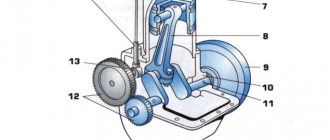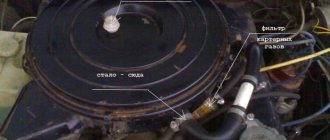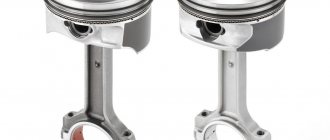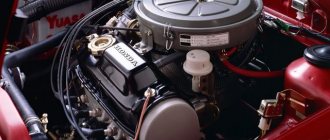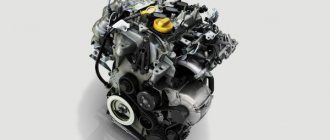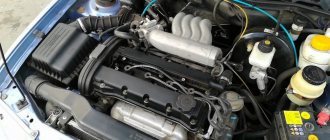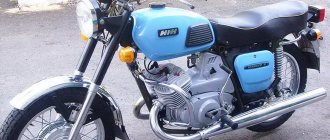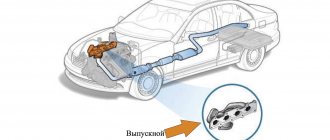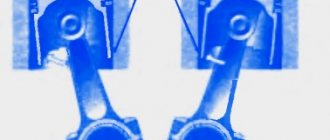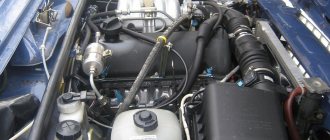General operating principle
The engine works as follows. The fuel mixture enters the combustion chamber, then it is compressed under the influence of the piston. After this, the mixture ignites. This leads to the expansion of combustion products, they press on the piston and exit the cylinder.
In two-stroke engines, one revolution of the crankshaft is completed in two strokes. A four-stroke piston engine completes its cycle in two revolutions of the crankshaft. The engines are equipped with a timing belt. What kind of mechanism is this? This is an element that allows the fuel mixture to be admitted into the chambers and combustion products to be released from there. The exchange of gases occurs at the moment of a single revolution of the crankshaft. Gas exchange occurs due to the movement of the piston.
How does a four stroke engine work?
Structurally, the working cycle of a typical four-stroke unit is ensured by the operation of the following elements:
- cylinder;
- piston - performs reciprocating movements inside the cylinder;
- intake valve – controls the process of supplying the air-fuel mixture to the combustion chamber;
- exhaust valve – controls the process of exhaust gases expelling from the cylinder;
- spark plug – ignites the resulting air-fuel mixture;
- crankshaft;
- camshaft - controls the opening and closing of valves;
- belt or chain drive;
- crank mechanism - translates the movement of the piston into rotation of the crankshaft.
Operating cycle of a four-stroke engine
The operating cycle of such a mechanism consists of four strokes, during which the following processes are implemented:
- Intake (fuel and air injection). At the beginning of the cycle, the piston is at TDC. At the moment when the crankshaft begins to rotate, it acts on the piston and moves it to BDC. This leads to the formation of vacuum in the cylinder chamber. The camshaft acts on the intake valve, gradually opening it. When the piston is in its extreme position, the valve is completely open, resulting in intense injection of fuel and air into the cylinder chamber.
- Compression (increasing the pressure of the combustible mixture). In the second stage, the piston begins to move back to the top dead center of the compression stroke. The crankshaft makes another turn and both valves are completely closed. The internal pressure increases to 1.8 MPa and the temperature of the combustible mixture rises to 600 C°.
- Expansion (working stroke). When the piston reaches the top position in the combustion chamber, the maximum compression is set to 5 MPa and the spark plug is fired. This leads to combustion of the mixture and an increase in temperature to 2500 C°. Pressure and temperature lead to an intense impact on the piston, and it begins to move back to BDC. The crankshaft makes another turn, and thus the thermal energy is converted into useful work. The camshaft opens the exhaust valve, and when the piston reaches BDC, it is fully open. As a result, the exhaust gases begin to gradually leave the chamber, and the pressure and temperature decrease.
- Exhaust (removal of exhaust gases). The engine crankshaft turns and the piston begins to move to the top point. This leads to the expulsion of exhaust gases and an even greater decrease in temperature and a decrease in pressure to 0.1 MPa. Next, a new cycle begins, during which these processes are repeated again.
During each stroke, the engine crankshaft rotates 180°. During a full working cycle, the crankshaft rotates 720°.
The four-stroke engine has become widespread. It can work with both gasoline and diesel fuel. The difference between the operating cycle for a diesel engine is that the ignition of the air-fuel mixture does not occur from a spark, but from high pressure and temperature at the end point of the compression stroke.
Story
The first device resembling a four-stroke engine was invented by Felicce Matoczi and Evgeniy Barsanti. But this invention was incredibly lost. Only in 1861 was a similar unit patented.
And the first usable engine was developed by German engineer Nikolaus Otto. The motor was named after the inventor, and the working cycle of the four-stroke engine also bears the name of this engineer.
Two-stroke engine.
The two-stroke and four-stroke cycles are similar only in that they involve compression and expansion of the working fluid. The cycles of filling the engine with fuel and its subsequent cleaning from combustion products are replaced by purging the engine near the BDC position of the piston. And the entire working cycle is completed within one revolution of the crankshaft.
If we talk about the two-stroke cycle, it is divided into the following strokes: initially, the piston rises up, compressing the working mixture in the cylinder, and also creating a vacuum in the crank chamber. The intake manifold valve opens from the effects of this vacuum, and a new portion of the combustible mixture (often with the addition of oil) is drawn into the crank chamber. When the piston moves down, the valve in the crank chamber closes and the pressure also increases. As for the rest: ignition, fuel combustion, and expansion of the working fluid occur identically as in four-stroke engines. But there is one nuance: at the moment when the piston lowers, approximately 60° before BDC, the exhaust window opens (the piston stops blocking it). Exhaust gases, under high pressure, rush into the exhaust manifold through this window. A little later, the piston also opens the intake window, which is located on the side of the intake manifold. A new portion of fuel from the crank chamber enters the working volume of the cylinder, under the influence of the descending piston, and displaces the remaining exhaust gases. In this case, a small part of the working mixture enters the exhaust manifold, but during the return stroke of the piston it is drawn back into the crank chamber.
The main differences between four-stroke engines
In a two-stroke engine, the piston and cylinder pins, crankshaft, bearings and compression rings are lubricated by oil added to the fuel. In a four-stroke engine, all components are installed in an oil bath. This is a significant difference. Therefore, in a four-stroke unit there is no need to mix oils and gasoline.
The advantages of the system are that the amount of carbon deposits on the mirror in the cylinders and on the walls of the muffler is significantly less. Another difference is that in two-stroke engines a combustible mixture enters the exhaust pipe.
Engine operation
Regardless of the type of motor, the principle of its operation is similar. Today there are carburetor engines, diesel engines, and injection engines. All models follow the same four-stroke engine operating cycle. Let's take a closer look at what processes work inside the motor and make it move.
A four-stroke cycle is a sequence of four power strokes. The start is usually taken to be the stroke when the combustible mixture enters the combustion chambers. Although other actions take place in the engine during its flow, the designated stroke is one working process. For example, the compression stroke is not just compression. During this period, the mixture is mixed in the cylinders, gas formation begins, and it ignites.
The same can be said about other stages of engine operation. The most important thing here is that the various processes for better understanding and simplification of the working cycle of a four-stroke engine are laid out into only four strokes.
Features of two-stroke engines
The basis of how a two-stroke engine differs from a four-stroke engine can be called the fact that in the first, the crankshaft makes two revolutions in one working cycle, and in the second, the entire working cycle fits into one revolution of the crankshaft (360°). The piston makes only two strokes. The processes occurring in the combustion chamber during the operating cycle of a two-stroke engine do not differ from four-stroke engines, but the intake of the combustible mixture and the exhaust gases are carried out simultaneously with the compression and expansion strokes.
The process of simultaneous removal of exhaust gases and injection of fresh charge into the cylinder, which occurs in a two-stroke engine, is called purging.
The operating principle of the simplest two-stroke engine is as follows:
- Compression stroke . At the beginning of the cycle, the piston is at BDC and moves to the TDC position on the compression stroke. In this case, the purge (inlet) window is blocked, and then the exhaust channel. At the moment when the piston closes the exhaust window, compression of the combustible mixture begins, and a vacuum occurs in the space under the piston. This ensures that fuel is forced into the chamber through the slightly open intake valve.
- Expansion stroke (power stroke). When the piston approaches TDC, the spark plug fires and the mixture ignites. This provokes a sharp increase in pressure and temperature, as a result of which the piston begins to move downwards. Thus, the gases perform useful work, and the piston, when moving to BDC, increases the compression of the air-fuel mixture. As pressure increases, the valve begins to close and prevents the combustible mixture from entering the intake manifold. When the piston reaches the exhaust window, the latter opens and exhaust gases are removed into the exhaust system. The pressure in the chamber decreases, and further movement of the piston opens the purge channel and the air-fuel mixture is supplied to the chamber, displacing the exhaust gases.
Depending on how the purge system is implemented in a two-stroke engine, they are divided into different types:
- With contour crank-chamber purging. The combustible mixture is supplied to the cylinder chamber directly from the engine crankcase. In this case, it is sucked in at the moment the piston moves to TDC, and when the piston moves to BDC, purging is ensured due to excess pressure.
- With valve-slit purge. Suitable for single cylinder engines. Gas distribution is realized by blocking the windows made in the cylinder wall.
- With direct flow blowing. In this design, the inlet is made through special purge windows made around the circumference of the cylinder in its lower part. In turn, the release is realized through the exhaust valve.
- Using purge pumps. Used on multi-cylinder two-stroke engines. In this case, the air for purging is compressed by a special compressor.
Unlike a four-stroke engine, a two-stroke engine does not have a gas distribution system. Such designs and organization of a complex lubrication system do not require. On the other hand, four-stroke engines are more fuel efficient, are also less susceptible to vibration and provide cleaner exhaust.
Source
Inlet
So, in the combustion chamber of a power unit, energy conversion cycles begin with the combustion reaction of the fuel mixture. In this case, the piston is at its highest point (TDC position), and then moves down. As a result, a vacuum occurs in the combustion chamber of the engine. Under its influence, the flammable liquid sucks in fuel. The inlet valve is in the open position, and the outlet valve is closed.
When the piston begins to move downward, the volume above it increases. This causes vacuum. It is approximately 0.071-0.093 MPa. Thus, gasoline enters the combustion chamber. In injection engines, fuel is injected by an injector. After the mixture enters the cylinder, its temperature can be 75 to 125 degrees.
How much the cylinder will be filled with the fuel mixture is determined by the filling coefficients. For engines with a carburetor power system, this figure will be from 0.64 to 0.74. The higher the coefficient value, the more powerful the motor.
The first stroke is intake.
The piston moves from TDC to BDC. The piston cavity of the cylinder that is released above is filled with a combustible mixture through the open inlet valve due to the resulting vacuum. The combustible mixture entering the cylinder is mixed with the remaining exhaust gases from the previous cycle to form a working mixture. At the end of the stroke, the pressure in the cylinder is 0.07–0.95 MPa, the temperature is 350–390 K, and the cylinder filling factor is 0.6–0.7.
Working stroke
This is the third stroke of the working cycle of a four-stroke internal combustion engine. It is the most important in the operation of the power unit. It is at this stage of engine operation that the energy from fuel combustion is converted into mechanical energy, causing the crankshaft to rotate.
When the piston is in a position close to TDC, even during the compression process, the fuel mixture is forcibly ignited by the engine spark plug. The fuel charge burns out very quickly. Even before the start of this stroke, the burned gases have a maximum pressure value. These gases are the working fluid compressed in a small volume of the engine combustion chamber. When the piston begins to move down, the gases begin to expand rapidly, releasing energy.
Of all the cycle strokes of a four-cylinder engine, this is the most useful. It operates on the load of the unit. Only at this stage does the crankshaft receive acceleration acceleration. In all others, the motor does not produce energy, but consumes it from the same crankshaft.
Release
After the gases have completed useful work, they must leave the cylinder to make room for a new portion of the fuel-air mixture. This is the last stroke in the working cycle of a four-stroke engine.
Gases at this stage are under pressure significantly exceeding atmospheric pressure. The temperature at the end of the stroke drops to about 700 degrees. The crankshaft, through the connecting rod, moves the piston to TDC. Next, the exhaust valve opens and the gases are pushed into the atmosphere through the exhaust system. As for pressure, it is high only at the very beginning. At the end of the stroke it decreases to 0.120 MPa. Naturally, it is impossible to completely get rid of combustion products in the cylinder. Therefore, during the next intake stroke they are mixed with the fuel mixture.
Description of the operating cycle of a four-stroke internal combustion engine
Cars are equipped with piston internal combustion engines (ICE), in which fuel burns inside the cylinder. Their action is based on the property of gases to expand when heated. Let's consider the principle of the design and operation of an internal combustion engine (ICE), as well as its operating cycles.
???? Duty cycle of a four-stroke gasoline engine
The engine operating cycle is a periodically repeating series of sequential processes occurring in each cylinder of the engine and causing the conversion of thermal energy into mechanical work. If the working cycle is completed in two strokes of the piston, i.e. per revolution of the crankshaft, then such an engine is called a two-stroke engine.
Car engines typically operate on a four-stroke cycle, which is completed in two revolutions of the crankshaft or four strokes of the piston and consists of intake, compression, expansion (power stroke) and exhaust strokes.
• The principle of operation of the internal combustion engine (to view, click on the illustration button – Photo 2-5
The extreme positions of the piston, at which it is most distant from the axis of the crankshaft or closest to it, are called the upper and lower “dead” points (TDC and BDC). Read more in the article “how gasoline and diesel engines work.”
Inlet. As the engine crankshaft makes its first half revolution, the piston moves from TDC to BDC, the intake valve is open, and the exhaust valve is closed. A vacuum is created in the cylinder, as a result of which a fresh charge of the combustible mixture, consisting of gasoline vapor and air, is sucked through the inlet gas pipeline into the cylinder and, mixing with residual exhaust gases, forms a working mixture.
Compression. After filling the cylinder with the combustible mixture, with further rotation of the crankshaft (second half-turn), the piston moves from BDC to TDC with the valves closed. As the volume decreases, the temperature and pressure of the working mixture increase.
Expansion or working stroke. At the end of the compression stroke, the working mixture is ignited by an electric spark and quickly burns, as a result of which the temperature and pressure of the resulting gases increases sharply, while the piston moves from TDC to BDC. During the expansion stroke, the connecting rod, pivotally connected to the piston, makes a complex movement and drives the crankshaft through the crank.
When expanding, gases perform useful work, so the piston stroke during the third half-turn of the crankshaft is called the power stroke. At the end of the piston's working stroke, when it is near BDC, the exhaust valve opens, the pressure in the cylinder decreases to 0.3 - 0.75 MPa, and the temperature to 950 - 1200 ° C.
Release. During the fourth half revolution of the crankshaft, the piston moves from BDC to TDC. In this case, the exhaust valve is open, and combustion products are pushed out of the cylinder into the atmosphere through the exhaust gas pipeline.
???? Working cycle of a four-stroke diesel engine
Unlike a gasoline engine, during the intake stroke, clean air enters the diesel cylinders. During the “compression” stroke, the air heats up to 600°C. At the end of this stroke, a certain portion of fuel is injected into the cylinder, which spontaneously ignites.
Operating procedure
The stages described constitute the operating cycle of a four-stroke gasoline engine. You need to understand that there are no strict correspondences between strokes and processes in piston engines. This can easily be explained by the fact that during operation of the power unit, the phases of the gas distribution mechanism and the state of the valves will be superimposed on the movements of the pistons in different engines in completely different ways.
In any cylinder, the working cycle of a four-stroke carburetor engine proceeds in exactly this way. Each combustion chamber in the engine is needed to rotate a single crankshaft, which receives the force from the pistons.
This alternation is called the operating order. This order is set at the design stage of the power unit through the features of the camshaft and crankshaft. It does not change during operation of the mechanism.
The operating order is implemented by alternating sparks that arrive at the spark plugs from the ignition system. So, a four-cylinder engine can operate in the following orders - 1, 3, 4, 2 and 1, 2, 4, 3.
You can find out the order in which the engine cylinders operate from the instructions for the car. Sometimes the operating procedure is indicated on the unit body.
This is how the working cycle of a four-stroke carburetor engine or any other engine proceeds. The power supply system does not affect the operating principle of the unit in any way. The only difference is that a carburetor is a mechanical power system that has certain disadvantages, but in the case of injectors, these disadvantages are not present in the system.
Compression stroke in a diesel engine
At this stage of operation, the piston in the combustion chamber moves upward towards TDC. Both valves in a car engine are closed. As a result of the work of the piston, the air in the cylinder is compressed. The compression ratio in a diesel engine is higher than in gasoline engines, and the pressure inside the cylinder can reach 5 MPa. Compressed air heats up significantly. Temperatures can reach 700 degrees. This is necessary for the fuel to ignite. On diesel engines it is supplied through injectors installed on each cylinder. In winter, glow plugs are involved in the work. They preheat the cold mixture. This makes it easier to start the engine in winter. But not all cars have such a system.
Gas expansion stroke in a diesel engine
When the piston of a diesel engine has not yet reached the top point at about 30 degrees along the crankshaft, the fuel injection pump supplies high pressure fuel into the cylinder through an injector. A value of 18 MPa is necessary so that the fuel can be finely sprayed and distributed throughout the entire volume in the cylinder.
Further, the fuel ignites under the influence of high temperatures and burns quickly. The piston moves to the bottom point. The temperature inside the cylinder at this moment is about 2000 degrees. Towards the end of the cycle the temperature decreases.
